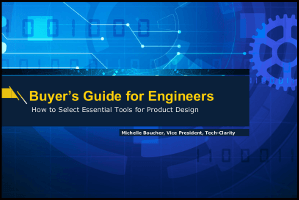 What software tools do engineers need to support product design? Which capabilities will help engineers develop products that are higher quality, more personalized, more innovative, and lower in ownership cost?
What software tools do engineers need to support product design? Which capabilities will help engineers develop products that are higher quality, more personalized, more innovative, and lower in ownership cost?
These are challenging tasks to achieve that are further complicated due to increasing product complexity, engineering changes, and multiple engineering disciplines. However, with the correct software solution, the challenges can be surmounted during product design. Tech-Clarity’s Buyer’s Guide for Engineers: How to Select Essential Tools for Product Design can do just that by providing guidance to help you choose the right solution for your company.
This guide is a starting point for tackling those challenges. It provides a high-level overview of requirements for a complete, integrated product design suite. Tech-Clarity’s buyer’s guides look beyond software requirements to the other elements that help companies get value from their solutions. Consequently, it includes criteria for implementation, adoption, service, and vendor selection. Further, each section contains a checklist to support your software evaluation efforts.
Please enjoy the summary* below. For the full eBook, please visit our sponsor Siemens (registration required).
TABLE OF CONTENTS
- Executive Overview
- The Business Value of Investing in Engineering
- Support End-to-End Processes with an Integrated Solution
- Mechanical Design
- Electrical and Electronic Design
- Simulation
- Manufacturing
- Technical Publications
- Design Data Management
- Service Requirements
- Vendor Requirements
- Identify Unique Company Needs
- Conclusion
- Recommendations
- About the Author
- Acknowledgments
Executive Overview
Global competition, including low-cost providers, makes it hard to compete in today’s market. It is impossible to compete on price when competitors come from geographic regions with low employment costs. Consequently, companies must compete in other ways, such as with better, high quality products, more personalization, improved services, greater innovation, or lower cost of ownership.
Achieving this requires improving efficiency, catching problems sooner, and making better decisions to lower product development costs and increase product quality. Consequently, teams must be agile enough to quickly respond to market shifts and customer demands. Products have to get to market as fast as possible to maximize the window of opportunity before low-cost providers can undercut prices with competing offerings.
The Value of Digitalization
Efficiencies achieved through digitalization accelerate the development process and improve quality by creating a digital thread across the entire product development cycle. As a result, all information stays up to date, changes are propagated, and there is less risk of errors. However, it can be hard to know where to start, especially for a small or mid-size company. Smaller companies share many of the same challenges as larger companies, but lack the budget of a big OEM. The right software solution can help, but it must have the right capabilities, at an affordable price that will be manageable for a small company.
Selecting the Right Solution
With so much to consider, how do you choose the right software solution to support your product life-cycle? This buyer’s guide serves as a guide to help you pick the right solution for your company.
This guide covers requirements for a complete integrated product development suite. It has four major sections covering software functionality, service requirements, vendor attributes, and unique company considerations (Figure 1). Each section includes a checklist of key requirements to investigate when selecting software tools. This guide is not an all-encompassing requirements list. It provides a high-level overview.

While the amount of embedded software in today’s products is growing, for the purposes of this guide, it was not considered part of the scope.
RECOMMENDATIONS
Based on industry experience and research for this report, Tech-Clarity offers the following recommendations:

- Create a digital thread across your development process with an end-to-end integrated product development suite
- Consider solutions that support mechanical design, electrical design, simulation, manufacturing, technical publications, and design data management.
- Ensure you have traceability across the entire lifecycle of your product
- Do not compromise on ease of use
- Support collaboration across the development lifecycle
- Work off a single high-fidelity model to support your digitalization strategy and create a single source of truth
- Ensure your solution will have the support behind it to make it a success at your company.
- Select a vendor who will be a good partner.
*This summary is an abbreviated version of the eBook and does not contain the full content. A link to download the full eBook is available above.
If you have difficulty obtaining a copy of the research, please contact us.

